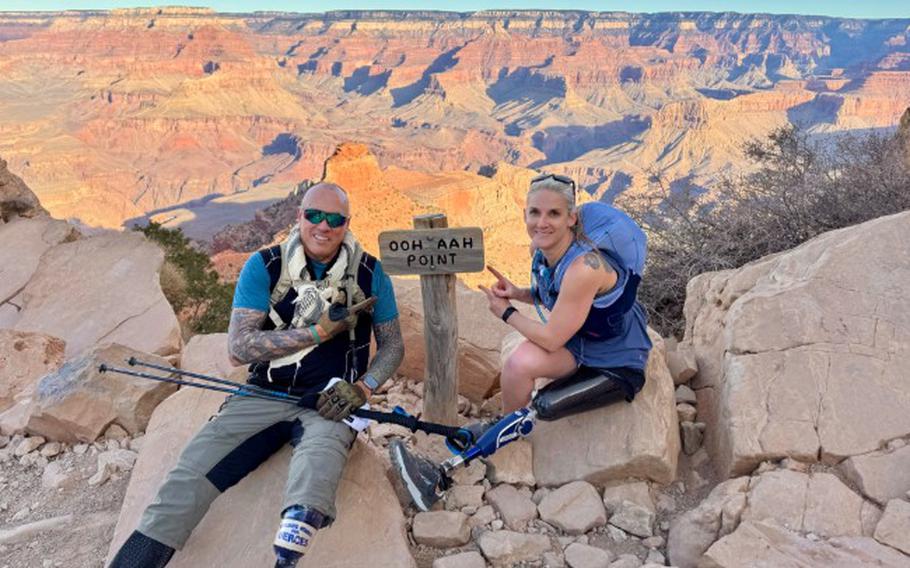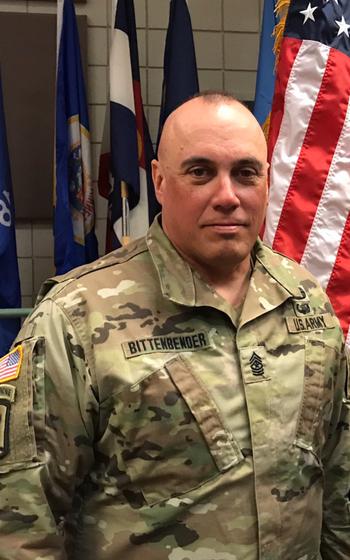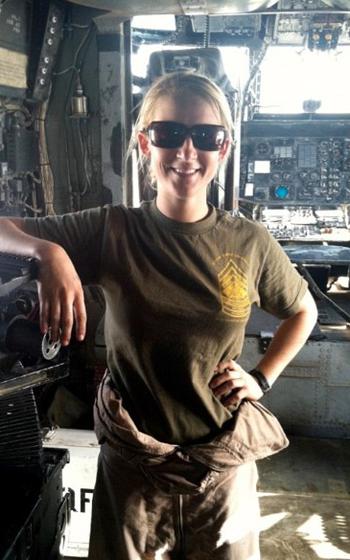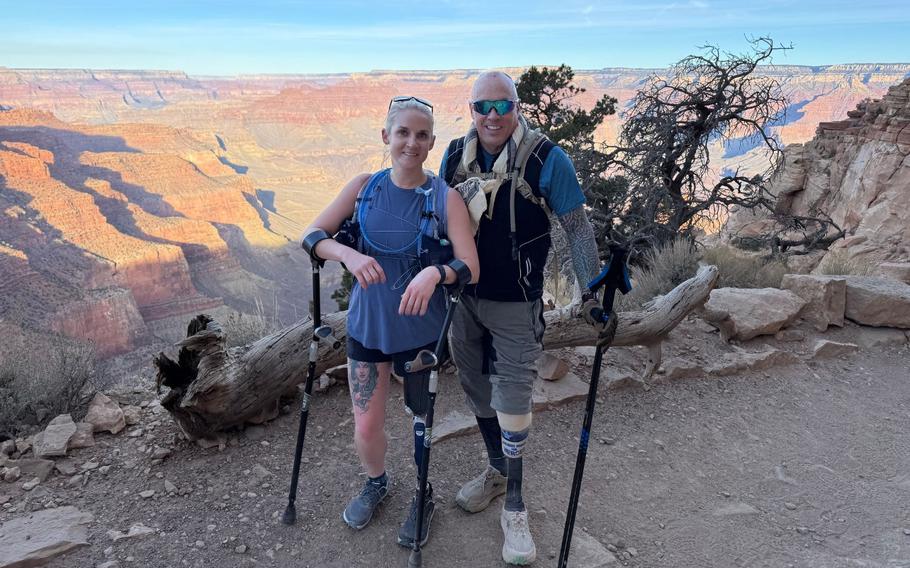
Retired Army Sgt. Maj. Kevin Bittenbender and retired Marine Sgt. Kirstie Ennis on a warm-up hike for their April 2025 effort to set a Guinness Book of World Records benchmark for amputee hikers attempting the Rim-to-Rim-to-Rim Trail at Grand Canyon National Park. (Building Homes for Heroes)
Kevin Bittenbender and Kirstie Ennis had done everything that they could do by Sunday night for “the big jump off” of a 47.5-mile Rim-to-Rim-to-Rim hike at Grand Canyon National Park.
Ennis, 34, a retired Marine sergeant, had flown in from Chile, where she had hiked Nevado Ojos del Salado, the tallest volcano in the world. Bittenbender, 56, a retired Army sergeant major, came to northern Arizona from training at his home in the Pocono Mountains of Pennsylvania.
Before dawn Monday, they planned to start the hike on a nearly 7,000-foot descent from the South Rim to the canyon floor and up almost 7,000 feet to the North Rim.
Then they would turn around and reverse the path back to the South Rim.
The veterans are carrying a list of supplies: trekking poles, micro spikes, headlamps, rain shells to cover backpacks, water filters, and a collection of energy snacks and electrolyte-filled drinks. The list includes a “prosthetics kit.”
Duct tape, metal adhesive, wrench set, glue, spare screws, spare clamp set for forearm crutches, and rubbing alcohol.
“En route, we will be checking in for limb and feet health,” Ennis said. “If legs do not need to come off, we sip a quick snack. If legs need to come off at any point due to concerns, we will stop — but at a minimum, we will be checking in with each other every two hours.”
Both hikers might need the kit.
Ennis had her left leg amputated above the knee following a 2012 helicopter crash in Afghanistan. She’s had 48 separate operations on her face, spine, and torso. She retired in 2015.
Bittenbender had his left leg partially amputated in 2022 from accumulated damage from exposure to toxic burn pits while deployed in Afghanistan. He retired in 2018.

Army Sgt. Maj Kevin Bittenbender was exposed to toxic fumes from burn pits while deployed in Afghanistan. He retired in 2018. His left leg was amputated below the knee in 2022. (Courtesy of Kevin Bittenbender)
Their goal at the Grand Canyon is to establish a new record in the Guinness World Records for “adaptive athletes” on the Rim-to-Rim-to-Rim trail.
They are also raising funds for Building Homes for Heroes, which gifts wounded and injured veterans with mortgage-free homes. The nonprofit provided more than 400 homes designed or modified with doors, windows, and interior spaces built to accommodate wheelchairs or amputee equipment for veterans. Bittenbender and Ennis live in houses adapted by the organization.
But the veterans cautioned how the trail’s deep, harsh descents and the heart-pounding ascents echo their life journeys.
Ennis is from Milton in the far west end of the Florida Panhandle. Her father and mother were also Marines.
When she turned 17, her parents signed the age waiver to allow her to enlist in the service too.
She became a helicopter mechanic for Marine Heavy Helicopter Squadron 362, nicknamed “Ugly Angels,” based at Marine Corps Air Station Kaneohe Bay in Hawaii. In flight, Ennis was a door gunner, eyeing the terrain from behind a .50-caliber machine gun.
In June 2012, during her second deployment to Afghanistan, her helicopter crashed on the way to supply ammunition to troops in the Helmand Province.
“Pilot error, they said,” Ennis said. “My pilot choked.”
The two pilots and three gunners aboard all survived. Ennis was the most severely injured.
The machine gun slammed into her face on impact, ripping out her teeth and breaking her jaw. She suffered a traumatic brain injury, dislocated both shoulders, ruptured both eardrums, and had several fractured vertebrae. Her left leg was shredded so badly that despite efforts to save the limb, it eventually had to be amputated above the knee in 2015.
During her rehabilitation in California, Ennis tried to drown herself. She survived and was back in the hospital when her father visited her.

Marine Sgt. Kirstie Ennis aboard a CH-53D Sea Stallion helicopter. Ennis was severely injured in a CH-53D crash in Afghanistan, eventually requiring the amputation of her left leg above the knee. (Courtesy of Kirstie Ennis)
“He said, ‘The enemy couldn’t kill you and you were going to do it for them?’ “ she recalled. “That was a real wake up call. I had been badly injured, but I made it home. A lot of people didn’t make it home. You have to live for them and the people they left behind.”
Ennis fought to stay in the Marine Corps, but after review boards weighed in, she retired.
That was the same year that Bittenbender fought his emotions and physical deterioration.
A native of northeastern Pennsylvania, Bittenbender joined the Army in 1986 when he turned 18. He served 34 years, rising to the rank of sergeant major.
While deployed in Afghanistan, he had been exposed to burn pits, where the Army incinerated trash, chemicals, medical waste, rubber, and plastic that created black smoke that was dense and acrid. It left his skin and organs scarred. His blood laced with toxins.
While in Afghanistan that year, Bittenbender’s friend was killed in an ambush. Already battling illness, he felt overwhelmed by sadness and was ready to act on the impulse.
“I had a rope — I was going to hang myself,” Bittenbender said. “I felt I was encumbering my family and my guys. I was in Afghanistan, so if I was going to end up dead on the side of a hill, it might as well be there.”
But Bittenbender said he thought about the last talk that he had with the officer he respected. They were interrupted when the order for the patrol to move out was given.
“He had said to me, ‘What do you want to be remembered for in life?’ “ Bittenbender recalled. “Before I could think of an answer, he had to go. We never got a chance to finish that conversation. But the question stayed with me.”
Bittenbender and Ennis found a way back to reviving their lives by reaching out to ask for help and offering help in return.
“In battle, soldiers don’t go in alone,” he said. “We have people in front of us, beside us, and behind us. The people you are fighting with are also who you are fighting for. You won’t be left behind.”
But that feeling can evaporate off the battlefield.

Retired Marine Sgt. Kirstie Ennis and retired Army Sgt. Maj. Kevin Bittenbender practice for their April 2025 effort to set a Guinness Book of World Records benchmark for amputee hikers attempting the Rim-to-Rim-to-Rim Trail at Grand Canyon National Park. (Building Homes for Heroes)
“One stripe or four stars, we all have troubles,” Bittenbender said. “We lose a lot of service members to suicide. Everybody needs a ‘battle buddy,’ someone you know that when the demons hit you in the middle of the night, you can call and know they won’t let you go to voicemail.”
Ennis now lives in Glenwood Springs, Colo., near Denver. But she’s traveled the world to hike mountain peaks and traveled the U.S. advocating for veterans and health issues.
Bittenbender works with veterans in his job on the staff of Pocono Raceway and mentors injured and wounded veterans at Walter Reed National Military Medical Center in Bethesda, Md. He’s run or wheeled in a chair in 44 marathons.
Bittenbender and Ennis met last year at a conference in New Jersey, where Ennis was appearing.
Bittenbender had an idea and he approached Ennis about it.
He had told her that he had never seen the Grand Canyon and wanted to go. Since he was a young boy, he’d been obsessed with Guinness World Records.
Bittenbender asked Ennis whether she would be interested in joining him to try and set a time record for “adapted athletes” for transversing the Rim-to-Rim-to-Rim Trail.
“I had never met him, but he was so motivated, and it sounded like a great challenge,” Ennis recalled. “I told him ‘You are on, big guy.’”
“We’re battle buddies,” Bittenbender said.
On Sunday, their Grand Canyon support crew included timers to document their speed on the trail, a videographer, and a runner who can bring replacement prosthetics to Bittenbender and Ennis if anything breaks on the trail.
The duo’s progress will be chronicled on Instagram, with the materials available online after the hike to show how they overcame challenges along the way.
After the Grand Canyon, Ennis plans to summit the world’s tallest peak, Mount Everest. She also plans on competing in snowboarding in the 2026 Winter Paralympics next March in Cortina d’Ampezzo, Italy.
Bittenbender said the Grand Canyon hike is enough for the moment.
“This is my bucket list,” he said.